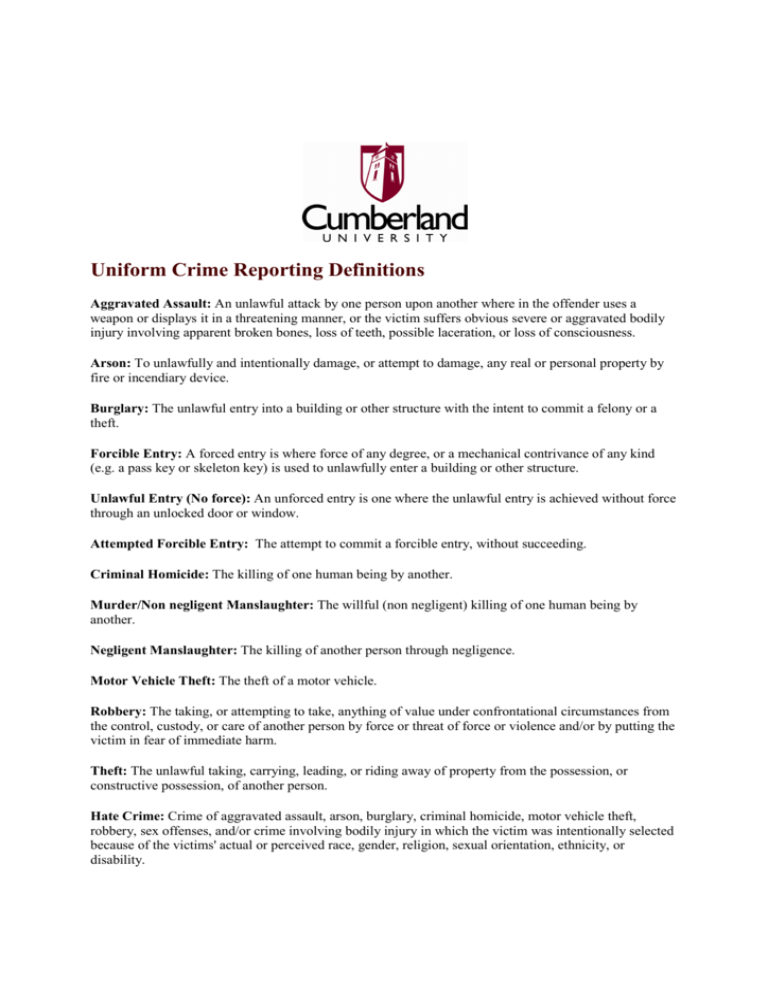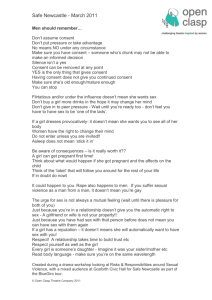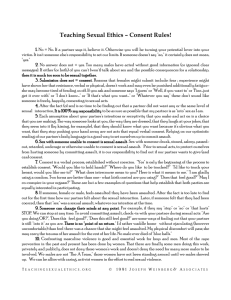
Uniform Crime Reporting Definitions
Aggravated Assault: An unlawful attack by one person upon another where in the offender uses a
weapon or displays it in a threatening manner, or the victim suffers obvious severe or aggravated bodily
injury involving apparent broken bones, loss of teeth, possible laceration, or loss of consciousness.
Arson: To unlawfully and intentionally damage, or attempt to damage, any real or personal property by
fire or incendiary device.
Burglary: The unlawful entry into a building or other structure with the intent to commit a felony or a
theft.
Forcible Entry: A forced entry is where force of any degree, or a mechanical contrivance of any kind
(e.g. a pass key or skeleton key) is used to unlawfully enter a building or other structure.
Unlawful Entry (No force): An unforced entry is one where the unlawful entry is achieved without force
through an unlocked door or window.
Attempted Forcible Entry: The attempt to commit a forcible entry, without succeeding.
Criminal Homicide: The killing of one human being by another.
Murder/Non negligent Manslaughter: The willful (non negligent) killing of one human being by
another.
Negligent Manslaughter: The killing of another person through negligence.
Motor Vehicle Theft: The theft of a motor vehicle.
Robbery: The taking, or attempting to take, anything of value under confrontational circumstances from
the control, custody, or care of another person by force or threat of force or violence and/or by putting the
victim in fear of immediate harm.
Theft: The unlawful taking, carrying, leading, or riding away of property from the possession, or
constructive possession, of another person.
Hate Crime: Crime of aggravated assault, arson, burglary, criminal homicide, motor vehicle theft,
robbery, sex offenses, and/or crime involving bodily injury in which the victim was intentionally selected
because of the victims' actual or perceived race, gender, religion, sexual orientation, ethnicity, or
disability.
Vandalism: The Uniform Crime Report definition for vandalism is: “Vandalism consists of the willful or
malicious destruction, injury, disfigurement, or defacement of any public or private property, real or
personal, without consent of the owner or person having custody or control by cutting, tearing, breaking,
marking, painting, drawing, covering with filth, or any other such means as may be specified by local law.
This offense covers a wide range of malicious behavior directed at property, such as: cutting auto tires,
drawing obscene pictures on public restroom walls, smashing windows, destroying school records,
tipping over gravestones, defacing library books, etc. Count all arrests for the above, including attempts.”
Sexual assault can be any form of forced sexual contact. Force can be physical or emotional (threat,
intimidation, pressure, coercion). Sexual assault is intentional and is committed either by
• physical force, violence, threat, or intimidation;
• ignoring the objections of another person;
• causing another's intoxication or impairment through the use of drugs or alcohol; or
• taking advantage of another person's incapacitation, state of intimidation, helplessness, or other inability
to consent.
Relationship violence, also known as "dating violence," "domestic violence," or "intimate partner
violence," is a chronic pattern of one partner in an intimate relationship using abuse to gain power and
control over the other person. Relationships violence can include:
• physical violence
• sexual violence
• psychological violence
• emotional violence
• economic abuse.
Sexual misconduct is sexual contact without intent to harm but also without the presence of effective
consent. Sexual Misconduct occurs when
• the act is committed without intent to harm another
• the perpetrator fails to ask for or correctly assess whether effective consent has been given
• unreasonably believes unreasonably that effective consent was given without having met his/her
responsibility to gain effective consent.
Sexual harassment includes threatening, inappropriate, unrelenting or abusive sexually explicit language
or behaviors towards. Sexual harassment can include saying or doing things:
• directly to someone
• during a phone conversation
• during an online conversation
• in print or on clothing
• and can be directed towards individuals or groups
Stalking is conduct directed at a specific person that would cause a reasonable person to feel fear.
Stalking is serious, often violent, and can escalate over time. Stalking behaviors include:
• Someone repeatedly calling, including hang ups
• Following someone
• Send unwanted gifts, letters, card or emails
• Damage to a residence, car or other property
• Monitoring phone calls or computer use
• Threatening to hurt someone, tor heir family, friends or pets
Effective Consent:
Clear Communication Words or actions must be used to establish consent. Only a comprehensible,
unambiguous, positive and enthusiastic communication of consent for each sexual act qualifies as
consent. The absence of no does not equal yes. Only YES means YES.
• Freely and Willingly: Effective consent must be established without any coercion, including
emotional, psychological or relational pressure or influence.
• Unimpaired Decision Making: Effective consent must be established without impairment by either
person. Impairment can include the effects of alcohol or other drugs. In addition, if someone is
asleep, passed out, has consumed alcohol or drugs, or is in any other way impaired, she or he cannot
give legal consent.
• Step-by-Step: You must establish effective consent for every sex act and each time you hook up.
Consenting to one sex act does not mean consenting to any other sex act. Prior sexual activity or an
ongoing relationship cannot substitute for effective consent.
• Subject to Change: At any point during a sexual encounter both partners should be free to change
their mind. If one partner changes his or her mind, then the other partner must respect the decision to
limit or end sexual contact.









